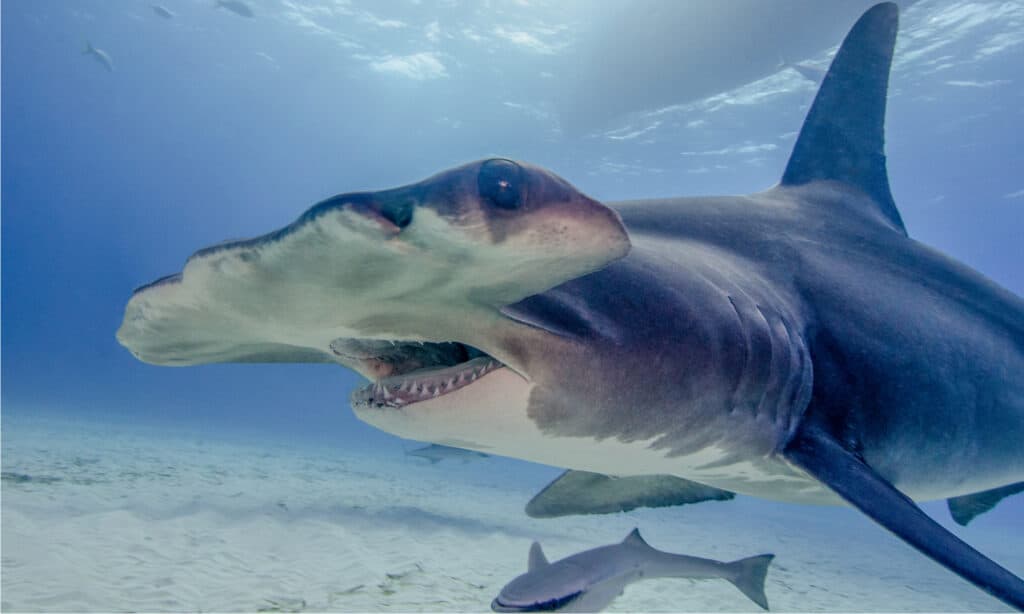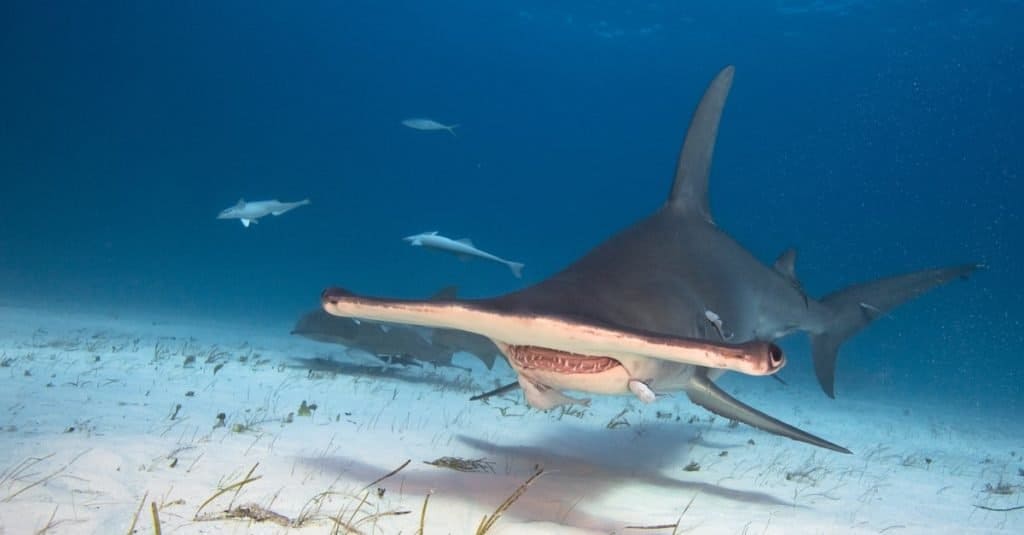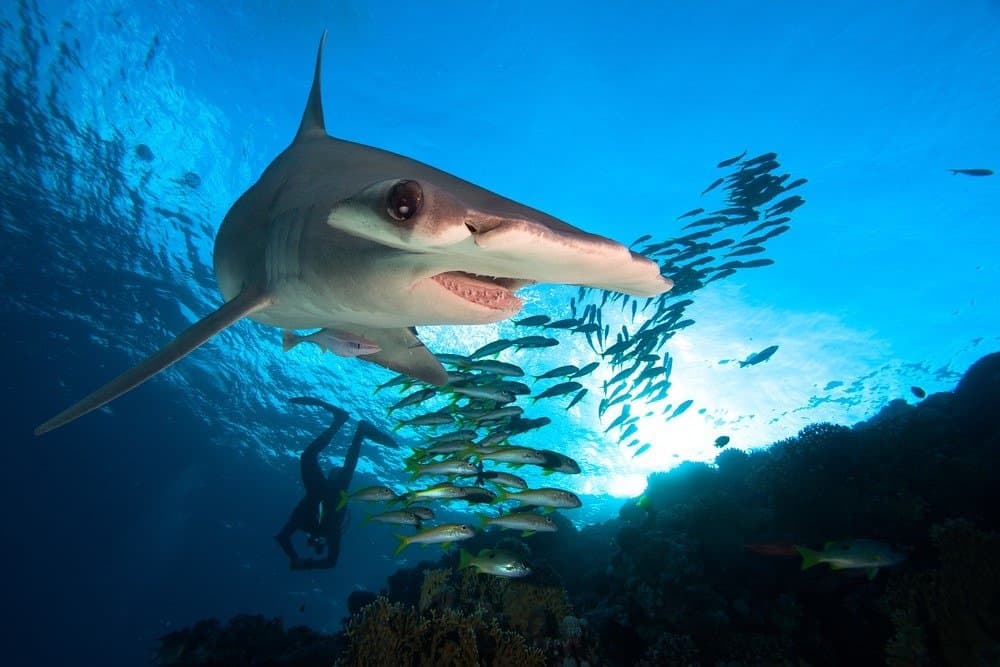Key Points:
- Florida Museum of Natural History’s International Shark Attack File, which covers all recorded shark attacks from the 1500s to current times, lists 16 nonfatal hammerhead attacks on humans.
- Fatal shark attacks often occur when sharks bite humans believing they are prey, but as hammerheads have electromagnetic sensors in their heads and a 360-degree field of view there is no such risk of confusion or mistaken identity.
- Unlike great whites, bull sharks, and tiger sharks, hammerhead sharks don’t eat mammals. So, humans almost never look like something good to eat to hammerheads.
According to the Florida Museum of Natural History’s International Shark Attack File (ISAF), there has never been a fatal hammerhead shark attack on a human. The ISAF covers all recorded shark attacks from the 1500s to current times. It is the only reliable, scientifically vetted, comprehensive report of shark attacks on humans. According to the ISAF, there have been a grand total of 16 nonfatal hammerhead attacks on humans in all the time humans have spent swimming in the world’s oceans.
Here, we’ll find out why these sharks, which can grow up to 20 feet long, seldom chomp into human flesh. And, we’ll learn why it’s the hammerheads, not us, who are really in danger.
Read on to learn more about hammerheads, and what you can do to prevent their extinction!
About Hammerheads
There are 10 species of hammerhead sharks. As a family, they’re part of the most threatened sharks, with almost every species being either endangered or critically endangered. The largest species is the great hammerhead (Sphyrna mokarran), which regularly reaches 13-15 feet long, but can grow up to 20 feet long. The smallest type of hammerhead is the bonnethead shark (Sphyrna tiburo) which reaches around five feet long.
Hammerheads’ Heads

The scientific term for the shape of a hammerhead’s head is cephalofoil.
©Brent Barnes/Shutterstock.com
Hammerhead sharks are some of the most unique predators in our oceans, but just why do they have such unique heads? Well, the hammerhead’s flattened, hammer-shaped head actually gives it some really cool benefits. First, with eyes at each side of the “hammer,” they can actually see all the way around their bodies in a 360-degree field of view. Second, their heads are packed with electromagnetic sensors that allow these sharks to sense even the tiniest of movements.
Habitat
It might surprise you to learn that hammerhead sharks actually live in almost all of the world’s oceans, just not in the deep parts. Hammerheads aren’t cold weather sharks, so you won’t find them around Antarctica, Canada, Greenland, or other frigid waters. But, you will find them in the shallow, coastal waters surrounding South America, Central America, parts of North America, Africa, Asia, and Australia. There are even hammerheads living around distant islands, like Hawaii.
Hunting Method
Hammerhead sharks hunt using their sensitive heads, literally. Using their electromagnetic sensors and all-seeing eyes, they can locate even the most hidden of prey. Some of the hammerhead’s favorite foods include stingrays, bony fish, and other sharks. It’s also thanks to their incredibly specialized heads that hammerheads so rarely attack humans, let’s learn a little more about that.
Are Hammerheads Dangerous to Humans?
Shark attacks on humans are incredibly rare, and fatal attacks are even rarer. Attacks almost always happen in shallow water, near populated coastal areas. The top three species, in terms of attacks on humans, are great white sharks, tiger sharks, and bull sharks. But, despite their common presence in coastal waters, hammerhead sharks very, very rarely attack humans.
But, that’s not all. There have only been 16 recorded cases of hammerheads biting humans, and not one of those cases resulted in a fatality. Despite the size of certain species, hammerheads pose no threat to humans. In fact, they’re known as gentle, inquisitive sharks whose presence can turn any snorkeling or diving experience into a once-in-a-lifetime story.
Why Are Attacks on Humans So Rare?

Hammerhead sharks don’t prey on mammals, so humans don’t fit their usual prey profile.
©frantisekhojdysz/Shutterstock.com
There are 10 species of hammerheads, some of which certainly get big enough to really do some damage to a human. And, hammerheads live in all the waters humans normally frequent. So, why aren’t attacks more common? Well, scientists believe the answer just might lie with the hammerhead’s unique head structure. Because they’re so sensitive, hammerhead sharks are very good at distinguishing what kind of creature they’re focused on. So, cases of mistaken identity (accidental bites on humans) are almost unheard of when it comes to hammerheads.
Another reason hammerheads rarely bite humans, has to do with what they eat. Unlike great whites, bull sharks, and tiger sharks, hammerhead sharks don’t eat mammals. So, humans almost never look like something good to eat, at least to hammerheads.
Are Hammerheads Endangered?

Hammerhead sharks are one of the most vulnerable shark species due to their habitats and gentle nature.
©frantisekhojdysz/Shutterstock.com
Overfishing, pollution, bycatch fatalities, and even sport and trophy fishing are decimating shark populations around the world. Hammerheads are one of the most vulnerable types of shark since they live in shallow coastal waters and have gentle, curious dispositions. Like many types of sharks, hammerheads are considered ‘keystone’ species. This means that if the sharks disappear, our ocean’s ecosystems will suffer and potentially collapse.
Today, the number one threat to hammerhead sharks is overfishing. These sharks are currently killed in the tens of thousands yearly for just one thing, their dorsal fins. If humans don’t act soon, the demand for shark fin soup will lead to the extinction of these incredible, unique creatures.
How Can You Help Hammerheads?
If you’re lucky enough to see a hammerhead shark in the wild, you’ll probably never forget it. To keep these extraordinary creatures swimming in our oceans for generations to come, it’s important to understand shark conservation. Some of the biggest threats to hammerheads across the world include shark fishing contests, commercial shark fishing for shark fin soup, plastic pollution, and overfishing in coastal waters. The best way to help preserve sharks, and our oceans, is to do your research and stand up for conservation.
The photo featured at the top of this post is © Sophie Hart/Shutterstock.com
Thank you for reading! Have some feedback for us? Contact the AZ Animals editorial team.







